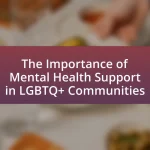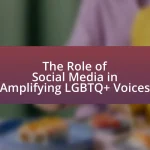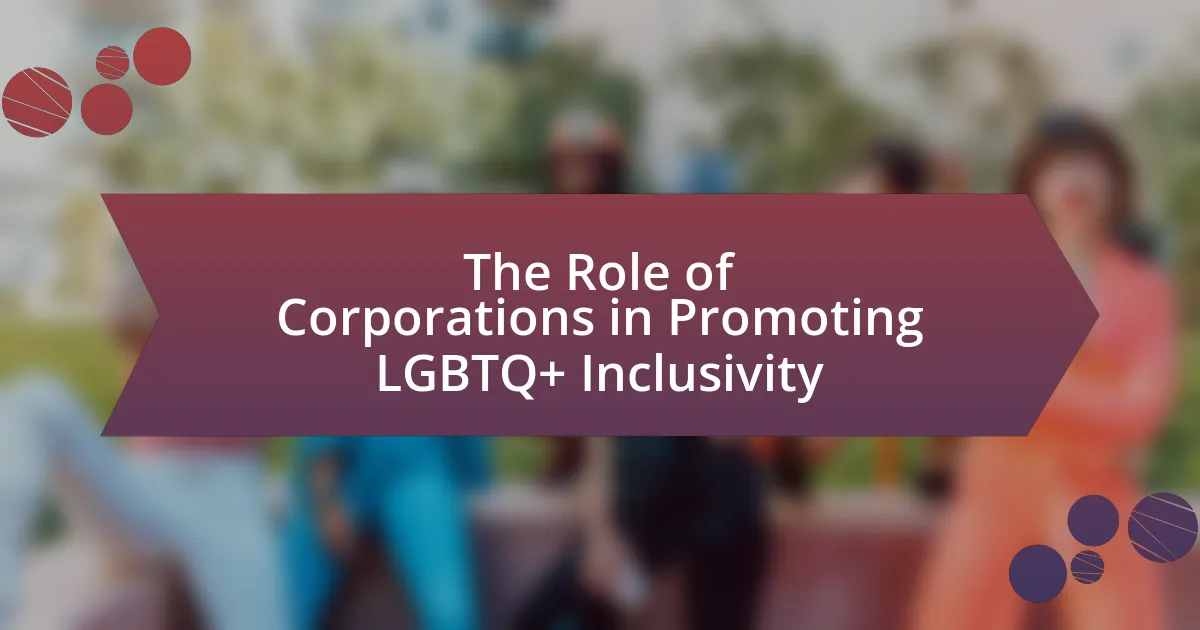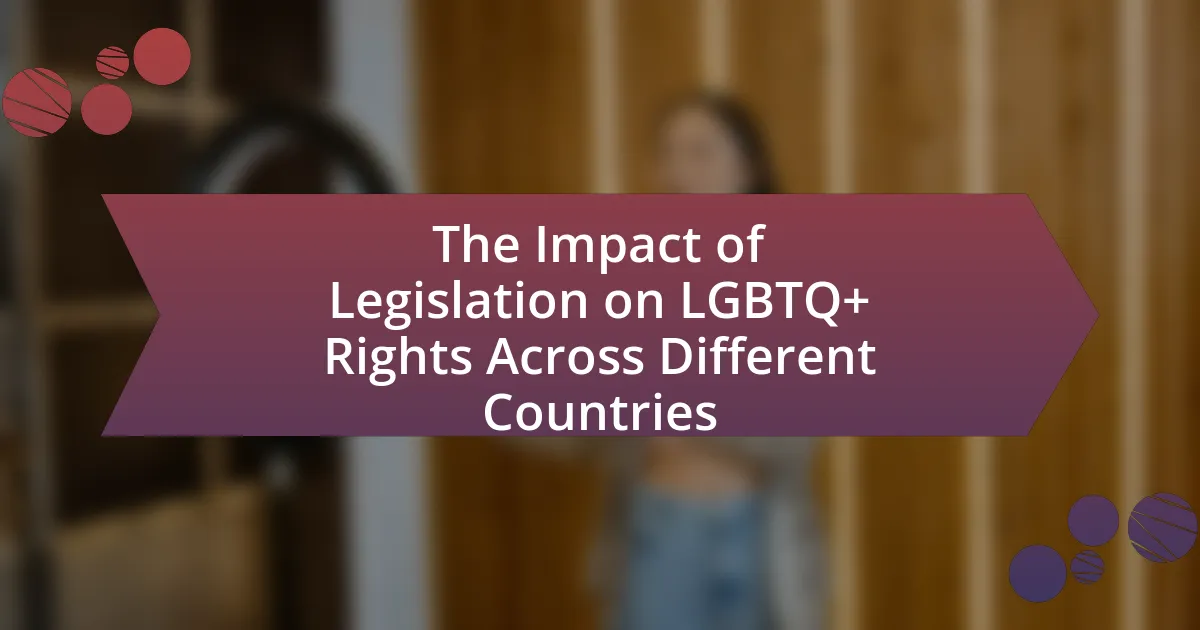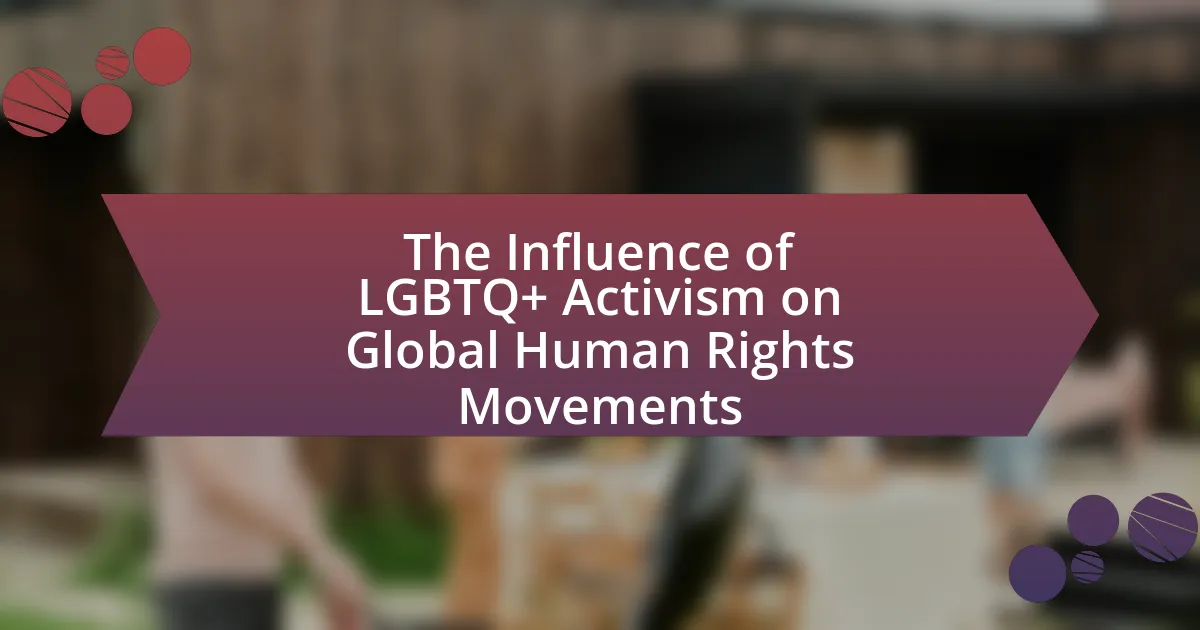The article “Celebrating LGBTQ+ Activism Through Art and Culture” explores the significance of LGBTQ+ activism in shaping artistic expression and cultural narratives. It highlights how art serves as a platform for marginalized voices, promoting visibility, acceptance, and social change through various forms such as visual arts, performance, and literature. Key themes discussed include identity, representation, and community, alongside historical milestones like the Stonewall Riots and the impact of contemporary artists. The article emphasizes the role of art in fostering solidarity within the LGBTQ+ community and outlines practical steps individuals can take to support LGBTQ+ activism through artistic engagement.

What is the significance of LGBTQ+ activism in art and culture?
LGBTQ+ activism in art and culture is significant because it challenges societal norms and promotes visibility and acceptance of diverse identities. This activism has historically provided a platform for marginalized voices, fostering community and solidarity through various artistic expressions such as literature, visual arts, and performance. For example, the Stonewall Riots of 1969 catalyzed a wave of artistic responses that highlighted the struggles and resilience of LGBTQ+ individuals, influencing movements like the AIDS activism of the 1980s, which utilized art to raise awareness and advocate for health rights. Furthermore, contemporary LGBTQ+ artists continue to reshape cultural narratives, as seen in the works of figures like Kehinde Wiley and Zanele Muholi, who confront issues of race, gender, and sexuality, thereby enriching the cultural landscape and promoting social change.
How has LGBTQ+ activism influenced artistic expression?
LGBTQ+ activism has significantly influenced artistic expression by promoting themes of identity, resistance, and social justice within various art forms. This activism has led to the emergence of diverse artistic movements, such as queer art, which challenges societal norms and highlights the experiences of marginalized communities. For instance, the Stonewall Riots of 1969 catalyzed a wave of artistic responses that addressed issues of oppression and visibility, inspiring artists like Keith Haring and David Wojnarowicz to create works that reflect the struggles and triumphs of the LGBTQ+ community. Additionally, the incorporation of LGBTQ+ narratives in mainstream media, such as films and literature, has broadened representation and fostered greater acceptance, as seen in works like “Moonlight,” which won the Academy Award for Best Picture in 2017, showcasing the complexities of queer identity.
What are the key themes in LGBTQ+ art and culture?
Key themes in LGBTQ+ art and culture include identity, representation, activism, and community. Identity is often explored through personal narratives and expressions of gender and sexual orientation, reflecting the diverse experiences within the LGBTQ+ spectrum. Representation is crucial, as artists strive to depict authentic LGBTQ+ lives and challenge stereotypes, which has been historically marginalized in mainstream art. Activism is a prominent theme, with art serving as a medium for social change, addressing issues such as discrimination, rights, and visibility. Community is also central, as LGBTQ+ art often fosters a sense of belonging and solidarity among individuals, celebrating shared experiences and histories. These themes are evident in various artistic movements and works, such as the Stonewall Riots’ influence on art in the 1960s and the ongoing impact of Pride events on contemporary artistic expressions.
How do artists convey messages of activism through their work?
Artists convey messages of activism through their work by utilizing visual elements, symbolism, and narrative techniques that reflect social issues and advocate for change. For instance, LGBTQ+ artists often incorporate vibrant colors, iconic symbols like the rainbow flag, and personal narratives to challenge societal norms and promote acceptance. Historical examples include Keith Haring’s graffiti-inspired art, which addressed AIDS awareness and LGBTQ+ rights in the 1980s, effectively raising public consciousness. Additionally, contemporary artists like Zanele Muholi use photography to document and celebrate the lives of LGBTQ+ individuals, thereby fostering visibility and dialogue around marginalized communities. These methods demonstrate how art serves as a powerful medium for activism, influencing public perception and inspiring action.
Why is representation important in art and culture for the LGBTQ+ community?
Representation is important in art and culture for the LGBTQ+ community because it fosters visibility, validation, and empowerment. When LGBTQ+ individuals see their identities and experiences reflected in art, it affirms their existence and combats societal marginalization. Studies show that representation in media can significantly impact self-esteem and mental health; for instance, a 2020 report by GLAAD found that LGBTQ+ representation in television positively influences acceptance and understanding among viewers. Furthermore, art serves as a powerful tool for activism, allowing LGBTQ+ artists to challenge stereotypes and advocate for rights, thereby contributing to broader social change.
What impact does visibility have on societal perceptions of LGBTQ+ individuals?
Visibility significantly enhances societal perceptions of LGBTQ+ individuals by fostering understanding and acceptance. Increased representation in media, politics, and public life leads to greater awareness of LGBTQ+ issues, reducing stigma and discrimination. For instance, studies show that positive portrayals of LGBTQ+ characters in television and film correlate with increased support for LGBTQ+ rights among viewers. According to a 2019 report by GLAAD, 20% of characters in scripted television were LGBTQ+, which reflects a growing acceptance and normalization of diverse identities. This visibility not only challenges stereotypes but also encourages dialogue, ultimately contributing to a more inclusive society.
How can art serve as a platform for marginalized voices within the LGBTQ+ community?
Art serves as a platform for marginalized voices within the LGBTQ+ community by providing a medium for expression, visibility, and advocacy. Through various forms of art, such as visual arts, performance, and literature, LGBTQ+ artists can share their unique experiences and challenges, fostering understanding and empathy among broader audiences. For instance, the Stonewall Riots of 1969, which were pivotal in LGBTQ+ activism, inspired countless artistic works that highlight the struggles and resilience of the community. Additionally, organizations like the Queer Arts Festival in Vancouver showcase LGBTQ+ artists, amplifying their voices and addressing social issues. This artistic representation not only validates the experiences of marginalized individuals but also encourages dialogue and social change, making art a crucial tool for empowerment and activism within the LGBTQ+ community.

What are the historical milestones of LGBTQ+ activism in art and culture?
The historical milestones of LGBTQ+ activism in art and culture include key events and movements that have shaped representation and advocacy. In the 1960s, the Stonewall Riots in 1969 marked a pivotal moment, igniting the modern LGBTQ+ rights movement and inspiring artists to express their identities and struggles through various forms of art. The 1970s saw the emergence of LGBTQ+ literature and theater, with works by authors like James Baldwin and plays such as “The Boys in the Band” challenging societal norms.
In the 1980s, the AIDS crisis profoundly influenced art, leading to the creation of powerful works that highlighted the epidemic’s impact, exemplified by the activism of groups like ACT UP and artists such as Keith Haring. The 1990s introduced the concept of queer theory, further influencing literature, film, and visual arts, with filmmakers like Gus Van Sant and artists like David Wojnarowicz gaining prominence.
The early 2000s witnessed increased visibility in mainstream media, with television shows like “Will & Grace” and films like “Brokeback Mountain” contributing to broader acceptance and representation. More recently, the rise of social media has allowed for diverse voices within the LGBTQ+ community to share their art and activism globally, exemplified by platforms like Instagram and TikTok. These milestones collectively illustrate the evolution of LGBTQ+ activism through art and culture, reflecting ongoing struggles for equality and representation.
How did the Stonewall Riots influence LGBTQ+ artistic movements?
The Stonewall Riots significantly influenced LGBTQ+ artistic movements by catalyzing a wave of creative expression that embraced activism and identity. Following the riots in June 1969, artists began to use their work as a platform to address issues of oppression, visibility, and community solidarity. This period saw the emergence of various art forms, including visual arts, theater, and literature, that reflected the struggles and triumphs of the LGBTQ+ community. For instance, the formation of groups like the Gay Liberation Front encouraged artists to create works that challenged societal norms and celebrated queer identities. Additionally, the riots inspired iconic works such as “The Normal Heart” by Larry Kramer, which highlighted the AIDS crisis and the need for activism. The impact of the Stonewall Riots is evident in the ongoing evolution of LGBTQ+ art, which continues to serve as a powerful vehicle for social change and representation.
What role did performance art play in the early days of LGBTQ+ activism?
Performance art played a crucial role in the early days of LGBTQ+ activism by providing a powerful medium for expression and visibility. Artists used performance to challenge societal norms, confront discrimination, and articulate the struggles of the LGBTQ+ community during a time of significant oppression, particularly in the 1960s and 1970s. Notable figures such as Keith Haring and David Wojnarowicz utilized their art to address issues like the AIDS crisis and homophobia, effectively raising awareness and fostering solidarity within the community. Performance art became a form of protest, allowing LGBTQ+ individuals to reclaim their narratives and demand recognition in a society that often marginalized them.
How have major art exhibitions highlighted LGBTQ+ issues over the decades?
Major art exhibitions have highlighted LGBTQ+ issues over the decades by showcasing the work of LGBTQ+ artists and addressing themes of identity, representation, and social justice. For instance, the 1993 exhibition “Hide/Seek: Difference and Desire in American Portraiture” at the Smithsonian National Portrait Gallery was groundbreaking as it was the first major museum exhibition to explore LGBTQ+ themes in American art, featuring artists like David Hockney and Andy Warhol. Additionally, the 2017 “Art & Activism: A Conversation” exhibition at the Leslie-Lohman Museum of Gay and Lesbian Art emphasized the intersection of art and LGBTQ+ activism, reflecting on the impact of the AIDS crisis and the ongoing fight for rights. These exhibitions not only provided visibility to LGBTQ+ artists but also fostered dialogue about the challenges faced by the community, thereby reinforcing the importance of representation in the art world.
What are some notable LGBTQ+ artists and their contributions?
Notable LGBTQ+ artists include Andy Warhol, who revolutionized pop art and challenged societal norms through his work, and Frida Kahlo, whose paintings explored identity, gender, and post-colonialism, reflecting her bisexuality and Mexican heritage. Additionally, Keith Haring used street art to advocate for LGBTQ+ rights and AIDS awareness, while RuPaul has significantly impacted drag culture and mainstream media, promoting visibility and acceptance of LGBTQ+ individuals. These artists have made substantial contributions to art and culture, influencing social movements and fostering greater understanding of LGBTQ+ experiences.
Who are the pioneering figures in LGBTQ+ art history?
Pioneering figures in LGBTQ+ art history include Andy Warhol, Keith Haring, and David Hockney. Andy Warhol, known for his pop art, explored themes of sexuality and identity, significantly influencing LGBTQ+ representation in art. Keith Haring’s graffiti-inspired works addressed social issues, including AIDS awareness and LGBTQ+ rights, making him a prominent activist artist. David Hockney, celebrated for his vibrant landscapes and portraits, has openly expressed his sexuality through his art, contributing to the visibility of LGBTQ+ experiences. These artists have played crucial roles in shaping the narrative of LGBTQ+ art and culture.
What contemporary artists are shaping the current landscape of LGBTQ+ activism through art?
Contemporary artists shaping the current landscape of LGBTQ+ activism through art include Kehinde Wiley, who is known for his vibrant portraits that challenge traditional representations of Black masculinity and sexuality. His work often recontextualizes classical portraiture to celebrate queer identities, as seen in his series “The World Stage.” Another significant figure is Zanele Muholi, a South African visual activist whose photography documents the lives of LGBTQ+ individuals, particularly Black lesbians, and aims to combat discrimination and violence. Additionally, artists like Felix Gonzalez-Torres use minimalistic installations to address themes of love, loss, and the AIDS crisis, fostering dialogue around LGBTQ+ issues. These artists exemplify how contemporary art serves as a powerful medium for activism, raising awareness and promoting social change within the LGBTQ+ community.

How does art serve as a tool for activism within the LGBTQ+ community?
Art serves as a powerful tool for activism within the LGBTQ+ community by providing a medium for expression, raising awareness, and fostering solidarity. Through various forms such as visual art, performance, and literature, LGBTQ+ artists convey messages about identity, rights, and social justice, often challenging societal norms and prejudices. For instance, the AIDS Memorial Quilt, created in the 1980s, not only memorializes those lost to the epidemic but also serves as a poignant reminder of the ongoing fight for LGBTQ+ rights and healthcare access. Additionally, art events like Pride parades incorporate artistic elements to celebrate diversity and promote visibility, effectively mobilizing communities and influencing public opinion. Thus, art not only reflects the struggles and triumphs of the LGBTQ+ community but also actively engages and inspires action towards equality and acceptance.
What forms of art are most commonly used for LGBTQ+ activism?
Visual art, performance art, music, and literature are the most commonly used forms of art for LGBTQ+ activism. Visual art, including paintings, murals, and photography, often conveys powerful messages about identity and rights, exemplified by works from artists like Keith Haring, whose art addressed AIDS awareness and LGBTQ+ visibility. Performance art, such as drag shows and theater, serves as a platform for expression and community engagement, with events like the annual Pride parades showcasing performances that celebrate LGBTQ+ culture. Music, particularly genres like pop and hip-hop, has been instrumental in promoting LGBTQ+ themes, with artists like Lady Gaga and Frank Ocean using their platforms to advocate for equality. Literature, including poetry and novels, provides narratives that reflect LGBTQ+ experiences, with authors like James Baldwin and Audre Lorde influencing social change through their written words. These forms of art not only raise awareness but also foster community solidarity and inspire activism.
How do visual arts, music, and literature each contribute to activism?
Visual arts, music, and literature each contribute to activism by providing powerful platforms for expression, raising awareness, and fostering community engagement. Visual arts, such as paintings and installations, often depict social issues and marginalized experiences, making complex topics accessible and emotionally resonant; for instance, Keith Haring’s artwork addressed AIDS awareness and LGBTQ+ rights in the 1980s, effectively mobilizing public support. Music serves as a rallying cry, with songs like “Born This Way” by Lady Gaga promoting acceptance and pride, while also uniting listeners around shared causes; the song became an anthem for the LGBTQ+ community, amplifying messages of inclusivity. Literature, including poetry and novels, offers narratives that challenge societal norms and inspire empathy; works like “Giovanni’s Room” by James Baldwin explore themes of identity and love, encouraging readers to reflect on their own beliefs and biases. Together, these art forms not only document struggles but also inspire action, making them integral to the fabric of activism.
What role does social media play in promoting LGBTQ+ art and activism?
Social media serves as a crucial platform for promoting LGBTQ+ art and activism by providing visibility, fostering community engagement, and facilitating the dissemination of information. It allows artists and activists to share their work widely, reaching diverse audiences and creating a sense of belonging among marginalized groups. For instance, campaigns like #PrideMonth and #TransRightsAreHumanRights have mobilized support and awareness, demonstrating the power of social media in amplifying LGBTQ+ voices. According to a 2020 report by the Pew Research Center, 70% of LGBTQ+ individuals use social media to connect with others in their community, highlighting its role in building networks and promoting cultural expression.
How can art foster community and solidarity among LGBTQ+ individuals?
Art can foster community and solidarity among LGBTQ+ individuals by providing a platform for expression, connection, and shared experiences. Through various forms of art, such as visual arts, performance, and literature, LGBTQ+ individuals can communicate their identities, struggles, and triumphs, creating a sense of belonging. For instance, events like Pride parades often feature artistic displays that celebrate LGBTQ+ culture and history, reinforcing community ties. Additionally, studies have shown that participation in art-related activities can enhance social cohesion and support networks within marginalized groups, as evidenced by the work of researchers like Dr. David P. Leong in “The Role of Art in Community Building” published in the Journal of Community Psychology. This demonstrates that art not only reflects the LGBTQ+ experience but actively cultivates solidarity and community among its members.
What are the benefits of collaborative art projects within the LGBTQ+ community?
Collaborative art projects within the LGBTQ+ community foster inclusivity, enhance social connections, and promote mental well-being. These projects create safe spaces for individuals to express their identities and experiences, which is crucial for community building. Research indicates that participation in collaborative art can reduce feelings of isolation and increase a sense of belonging among LGBTQ+ individuals. For instance, a study published in the Journal of Community Psychology found that community art initiatives significantly improved participants’ self-esteem and social support networks. Additionally, collaborative art projects often address social issues, raising awareness and advocating for LGBTQ+ rights, thereby contributing to activism and cultural representation.
How do art festivals and events promote LGBTQ+ culture and activism?
Art festivals and events promote LGBTQ+ culture and activism by providing a platform for visibility, expression, and community engagement. These gatherings often showcase works by LGBTQ+ artists, highlighting diverse narratives and experiences that resonate within the community. For instance, events like Pride festivals incorporate art exhibitions, performances, and workshops that celebrate LGBTQ+ identities, fostering a sense of belonging and solidarity. Additionally, studies have shown that participation in such events can increase awareness and support for LGBTQ+ rights, as they often include discussions on social issues, thereby educating attendees and encouraging activism.
What practical steps can individuals take to support LGBTQ+ activism through art?
Individuals can support LGBTQ+ activism through art by actively engaging in and promoting LGBTQ+ artists and their work. This can be achieved by attending LGBTQ+ art exhibitions, purchasing art from LGBTQ+ creators, and sharing their work on social media platforms to increase visibility. Additionally, individuals can participate in community art projects that focus on LGBTQ+ themes, volunteer for organizations that support LGBTQ+ artists, and advocate for inclusive representation in public art spaces. Supporting initiatives like Pride art festivals or LGBTQ+ art grants also contributes to the sustainability of LGBTQ+ artistic expression. These actions not only elevate LGBTQ+ voices but also foster a more inclusive cultural landscape.
How can one engage with and promote LGBTQ+ artists in their local community?
To engage with and promote LGBTQ+ artists in their local community, individuals can organize events such as art shows, open mic nights, or workshops specifically highlighting LGBTQ+ talent. These events create platforms for artists to showcase their work and connect with audiences. For instance, community centers or local galleries can collaborate with LGBTQ+ organizations to host exhibitions that feature diverse artistic expressions, thereby fostering visibility and support. Research indicates that community engagement in the arts can enhance social cohesion and promote inclusivity, as seen in initiatives like the Queer Arts Festival in Vancouver, which has successfully elevated LGBTQ+ artists since its inception in 2009.
What resources are available for those interested in learning more about LGBTQ+ art and activism?
Numerous resources are available for those interested in learning more about LGBTQ+ art and activism, including books, online platforms, and community organizations. Notable books such as “The Queer Art of Failure” by Jack Halberstam and “Queer (In)Justice” by Joey L. Mogul, Andrea J. Ritchie, and Kay Whitlock provide critical insights into the intersection of art and activism. Online platforms like the LGBTQ+ Arts and Culture section of the Smithsonian Institution’s website offer curated exhibitions and educational materials. Additionally, organizations such as the Leslie-Lohman Museum of Gay and Lesbian Art and the Queer Cultural Center host events and provide resources that promote LGBTQ+ artistic expression and activism. These resources collectively contribute to a deeper understanding of LGBTQ+ art and its role in social change.

